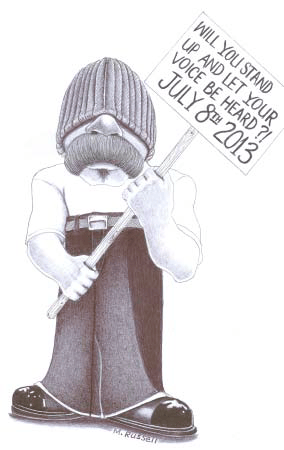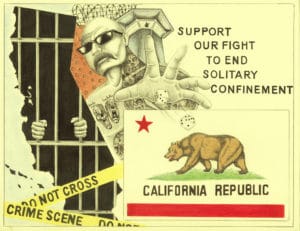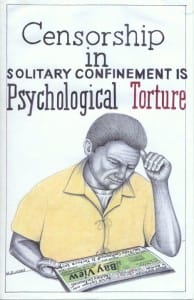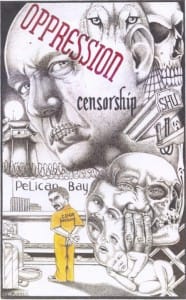by Claude Marks and Isaac Ontiveros
Four years ago prisoners in California – led by those in the control units of Pelican Bay – organized a hunger strike to demand an end to the torturous conditions of solitary confinement. Two more strikes would follow, with over 30,000 prisoners taking united action in the summer of 2013 – both in isolation and in general population in nearly every California prison.

The strikes reflected significant shifts in political consciousness among prisoners and their loved ones. The violence of imprisonment was further exposed by demands and heightened organization from within the cages. Prisoner-led collective actions as well as growing public support dramatically have changed the political landscape.
The organization of hunger strikes in 2011 surprised many, especially the CDCr – the California Department of Corrections and Rehabilitation (the lower case ‘r’ used by most prison writers derides the Orwellian use of the word rehabilitation), the media and much of the public.
The strikes reflected significant shifts in political consciousness among prisoners and their loved ones. The violence of imprisonment was further exposed by demands and heightened organization from within the cages.
Current prison organizing continues a historic legacy of struggle. Among prisoners, the strikes of 2011-2013 were compared to the Attica Rebellion of 1971. Shortly before that rebellion, prisoners at Attica refused to speak or eat in the facility’s chow hall, paying tribute to Black Panther Party member and California prison movement leader George Jackson, who had been assassinated at San Quentin prison Aug. 21.
Jackson was a skilled and effective leader who connected the human rights demands of prisoners to revolutionary ideas both globally and in the streets. He argued with powerful clarity that racist and exploitive power relations could and should be changed through political and military struggle, and that Black liberation was achievable as part of an international struggle to destroy imperialism.
Within the prisons, he built unity across racial lines – thinking that a unified prison movement could succeed in winning basic human rights both within the cages and in oppressed communities. While the state obviously found Jackson’s ideas and example extremely dangerous, many prisoners and community members found them a clarion call for action.
Jackson was a skilled and effective leader who connected the human rights demands of prisoners to revolutionary ideas both globally and in the streets.
On Sept. 9, 1971, Attica erupted. Led by prisoners affiliated with the Nation of Islam, the Black Panther Party, the Young Lords and the Five Percenters, the rebellion seized control of several large areas of the prison and issued a manifesto demanding, among other things, better health conditions, an end to political persecution of prisoners, and a right to organize or join labor unions. These demands were very similar to the Folsom Prison manifesto written in California in 1970.
After four days of negotiations, New York Gov. Nelson Rockefeller ordered that the prison be retaken. In the ensuing brutal military assault, 39 people were killed by state police and prison guards.
While Attica is one of the most remembered uprisings, between the late 1960s and the early 1980s, there were over 300 prison rebellions across the U.S., including those at the Oklahoma State Penitentiary in 1973, the Idaho State Penitentiary in 1972-3, the August Rebellion in 1974 at Bedford Hills Correctional Facility for Women in New York State, a 1975 demonstration at the North Carolina Correctional Center for Women and the Penitentiary of New Mexico in 1980.
In response to these militant uprisings, prisons developed unprecedented strategies of repression and isolation, and for a time resistance took less dramatic forms. Yet prisoners were still inspired to resist. In one example, in 1995, women in California state prisons initiated a class action lawsuit against genocidal health care conditions and successfully organized family members and allies across the state to support them.

Prisoners in California in 2011-2013 organized against the very policies, strategies and technology that had been put into place to neutralize the rebellions of previous decades, both inside and outside prison, including solitary confinement, gang validation – which includes the criminalization of George Jackson’s writings – and the gutting of educational programming. In turn, prisoners used similar historic strategies – collective direct action, multiracial unity, and building strong support and solidarity networks on the outside.
When prisoners went on hunger strike, they issued five core demands that called for an end to the California prison system’s use of long-term solitary confinement, gang validation and collective punishment, and they demanded better food and access to educational programing. The hunger strikes followed fruitless complaints and attempts to negotiate and ignited the political energies of tens of thousands of imprisoned people in a majority of California prisons, while also sparking life into a vast solidarity network led by prisoners’ families and loved ones, former prisoners and anti-prison organizations.
The strike was multi-pronged. It included a legal, legislative and mass media strategy, as well as organizing prisoner-led solutions to violence on the inside. Support for the strike was broad and international. Imprisoned people – from those held in detention centers in Washington and Texas to prisoners in Georgia, Ohio, Illinois and Guantanamo, to Palestinian political prisoners held by the state of Israel – all took inspiration from and expressed solidarity with the strike.
When prisoners went on hunger strike, they issued five core demands that called for an end to the California prison system’s use of long-term solitary confinement, gang validation and collective punishment, and they demanded better food and access to educational programing.
From the outset and over the course of three mass actions, the strikers were clear that their demands could be met by honest negotiation and moderate reforms. Todd Askher of the Short Corridor Collective at Pelican Bay explained, “Our struggle adheres to the principles of the Constitution and International Treaty Law and is inspired by all oppressed people’s demands for human rights, dignity, respect, justice and equality – the demand to be treated as living beings.”
In turn, the CDCr took an entrenched position – dismissed the legitimacy of prisoners’ concerns, retaliated against strike participants, targeted the strike leadership, harassed prisoners’ loved ones and supporters, and launched a generally harsh and fear-mongering public relations campaign.
Maintaining a collective stance, in May of 2012, prisoners who had spent over 10 years in isolation filed a class action civil lawsuit in federal court charging that their being held in solitary confinement constituted a violation of prisoners’ Eighth Amendment rights against cruel and unusual punishment. To date, the CDCr’s attempts to dismiss and defang the suit have been unsuccessful.
Todd Askher of the Short Corridor Collective at Pelican Bay explained, “Our struggle adheres to the principles of the Constitution and International Treaty Law and is inspired by all oppressed people’s demands for human rights, dignity, respect, justice and equality – the demand to be treated as living beings.”
Reminiscent of George Jackson’s call 40 years ago to “settle your quarrels [and] come together,” in 2012, California prisoners issued an Agreement to End Hostilities. In it they declared, “Now is the time for us to collectively seize this moment and put an end to more than 20-30 years of hostilities between our racial groups,” encouraging prisoners to resolve their differences, one of the most feared developments to prison officials.
An anonymous prisoner characterized the Agreement as something that creates new horizons for prisoner unity, beyond the demands for an end to long-term solitary and validation: “The inclusion of the Agreement to End Race-Based Hostilities to our struggle against California’s solitary confinement policies represents a qualitative leap of the insight of all prison nationalities and unites us beyond the fight to free ourselves from CDCr’s torture units.”
Two other prison leaders, Kijani Tashiri Askari and Akili Castlin at Tehachapi prison, enlarged upon this by writing that, when it comes to power: “Our exemplary conduct has made CDCr completely powerless over us, as we have successfully taken away the fodder that used to fuel their political rhetoric in labeling us the ‘worst of the worst.’ Our unity now qualitatively threatens the political, social and economic stability of the CDCr.”

Key to organizing direct support and solidarity efforts around the strikes – including spreading the word about the Agreement to End Hostilities in communities across California – were the family members and loved ones of the prisoners leading and participating in the strike. The prisoner action also had the inspiring effect of renewing connections between prisoners and their families, who grew from being personal supporters to participants and new leaders of the movement against solitary confinement and the wider anti-prison movement.
“The inclusion of the Agreement to End Race-Based Hostilities to our struggle against California’s solitary confinement policies represents a qualitative leap of the insight of all prison nationalities and unites us beyond the fight to free ourselves from CDCr’s torture units.”
The hunger strikers made it clear that they also wanted to help shine a light on the conditions of isolation in women’s prisons, which too often are even more invisible and ignored than those in men’s prisons. In January of 2013, California Families Against Solitary Confinement – founded by hunger strikers’ loved ones and overwhelming led by women of color – mobilized as part of a coalition organized by the California Coalition for Women Prisoners, bringing hundreds of community members from across California to protest the devastating impacts of overcrowding at Central California Women’s Facility (CCWF) in the Central Valley city of Chowchilla.
Medical care had significantly deteriorated and there was a dramatic increase in women being thrown into isolation. Overcrowding in women’s prisons has aggravated mental health issues, causing an increase in the number of mentally disabled people in the SHU even though this is the worst place to put them.
The hunger strikers made it clear that they also wanted to help shine a light on the conditions of isolation in women’s prisons, which too often are even more invisible and ignored than those in men’s prisons.
In recent years there were several preventable deaths at CIW and as well as numerous attempted suicides. None of the deaths have been made public by the prisons although they clearly signify a state of crisis.
April Harris, imprisoned at California Institution for Women in Corona, described conditions there around the time of the protest: “We have women dropping like flies, and not one person has been questioned as to why … I have been down almost 20 years and I have never seen anything like this. Ever.”
The hunger strikes helped to address the too often ignored struggles of imprisoned women – now close to 115,000 in the U.S. – and trans people against solitary confinement and other violent prison conditions. Many women and trans prisoners also refused food in solidarity with the overall demands emerging from the leadership in Pelican Bay.
An energized movement was critical to supporting the 2013 strike – coordinating mass support, maintaining good communication among prisoners, and developing a strategy to give voice to those inside despite their isolation and lockdowns. The solidarity effort was able to establish a relationship with the United Nations Special Rapporteur on Torture and was also able to convince key California state politicians to recognize the legitimacy of the strikers’ demands and to hold special public hearings on solitary confinement.

This solid work undermined the CDCr’s entrenched position and supported the prisoners when they decided to suspend the strike in order to support the public hearings.
In the mass media, in the communities and even among elected officials, the conditions, uses and devastating effects of – along with the term itself – solitary confinement was pulled from out of the shadows and thrust into the spotlight. In turn, the California prison regime did everything in its power to suppress the strike, retaliate against its participants, target and neutralize its leadership, regain an upper hand in public opinion and reconsolidate its control, even at the cost of making concessions and changes to its policy.
One of the Pelican Bay leaders, Todd Ashker, reflected on the historical impact of their mass actions: “I personally believe the prisoncrats’ efforts to turn the global support we have gained for our cause against us will fail. CDCr rhetoric indicates desperation – a very concerning desperation in the sense that it is demonstrative of CDCr’s top administrators’ intent to continue their culture of dehumanization, torture and other types of abusive policies and practices.
“Our key demands remain unresolved. The primary goal is abolishing indefinite SHU and Ad Seg confinement and related torturous conditions therein: the abolishment of the debriefing policy and meaningful individual accountability.”
At one time, the leaders of the strike were all in the same prison at Pelican Bay. The PBSP SHU Short Corridor Collective was originally Todd Ashker, Arturo Castellanos, Sitawa Nantambu Jamaa (Dewberry) and Antonio Guillen; and the Representatives Body was Danny Troxell, George Franco, Ronnie Yandell, Paul Redd, James Baridi Williamson, Alfred Sandoval, Louis Powell, Alex Yrigollen, Gabriel Huerta, Frank Clement, Raymond “Chavo” Perez and James Mario Perez, as of September 2013, when prisoners suspended the third hunger strike.
The CDCr has dispersed the leadership by sending some people to other SHUs, including Tehachapi and Corcoran prisons. These prisoners largely remain in isolation, despite some having been sent to general population. According to the prisoners themselves and those in close contact with them, rather than suffering a complete collapse in leadership and unity, the prisoners have reorganized and reconstituted an inclusive structure by bringing more people into representative and leadership positions in these other prisons. Their ability to organize and build new leadership has defied the CDCr’s attempts to demobilize and demoralize the struggle.
“Our key demands remain unresolved. The primary goal is abolishing indefinite SHU and Ad Seg confinement and related torturous conditions therein: the abolishment of the debriefing policy and meaningful individual accountability.”
What the CDCr is peddling as a reform is a Step Down Program (SDP). The SDP claims to offer an “incentive-based, multi-step process that affords offenders placed in a Security Housing Unit (SHU) due to validations and/or documented Security Threat Group (STG) behaviors [‘STG’ replacing the word ‘gang’ in policy] the opportunity to earn enhanced privileges and to demonstrate the ability to refrain from STG behavior, with the ultimate goal of release from the SHU.”
The SDP consists of five steps. Typically, Steps 1-2 to take a year to complete, although in some cases they can be completed within six months. Steps 3-5 each take a minimum of a year to complete. Each step imposes benchmarks on prisoner behavior and participation. A person may be placed in any step or may be released to the general population at the SDP review board’s discretion.

The best scenario that the average person placed in Step 1 can anticipate is that it will take at least four years before s/he is released from the SHU to the general population – assuming that this is ever even a possibility. A prisoner can be bumped backward in the process by administrative discretion, with no due process.
Informing on fellow prisoners is also an element of the SDP. Most of those who led the strike have refused to go along with the new program. Mutope Duguma at Pelican Bay says: “We have been able to examine, evaluate and investigate the STG and SDP policies and we unanimously reject them, because, simply put, they are more of the same. They empower the previous policies that we were initially peacefully protesting.”
The CDCr has also tried to use the SDP as a response to the class action civil suit – hoping a dispersal of plaintiffs would nullify their claims and standing as a class within the courts. However, the courts ruled that despite being dispersed, prisoners who met the criterion of 10 years or more in isolation continue to have standing in raising constitutional questions about prolonged isolation.
Conditions for prisoners and their families, particularly following the strikes, are very serious. As Mutope Duguma says: “CDCr has turned up its attacks, making it worse for each and every prisoner and his or her family. New regulations on personal property and on ‘obscenity’ – actually censorship, a direct attack on free speech – have been implemented, and the proposed regulations to use canine searches of visitors – a direct attack on our families – are not yet approved but are in effect on a temporary basis.”
Since 2011, imprisoned people living in some of the worst conditions imaginable have been able to organize and take collective action. They have created unity around agreed-upon goals and have coordinated multiple strategies using diverse tactics. Prisoners understand that their fight, like most freedom struggles, is long term. They have built alliances with different movements, peoples and communities.
Since 2011, imprisoned people living in some of the worst conditions imaginable have been able to organize and take collective action.
The CDCr’s primary goal is to maintain control and legitimacy – using whatever means. The state of California may be forced to offer some concessions given the advances made by the prisoners’ struggle. Some individuals will experience improved conditions, but we would do well to remember the warning of political prisoner Jamil Al-Amin (speaking then as H. Rap Brown): “We tend to equate progress with concessions. We can no longer make that mistake.”
The strike of 2011-2013 and the unity reflected by the coordinated action of 30,000 prisoners will continue to embolden those at the center of the struggle and, with the support of families and communities, will empower ongoing challenges to the violence of imprisonment, policing and social inequity. The strikes have helped to generate national movement against solitary confinement joined by people inside and outside prisons in many different states.
Prisoners understand that their fight, like most freedom struggles, is long term. They have built alliances with different movements, peoples and communities.
Several states have pending legislation against long-term solitary confinement. Most importantly, public consciousness is shifting to understand that solitary is torture and must be ended. As one of the statements from prison hunger strikers at Pelican Bay said: “This struggle has contributed to progressively changing attitudes in society and prisons. Our collective efforts have repeatedly exposed the state’s contradictions and sparked the people’s appetite for freedom and new social relationships.”
Claude Marks, director of Freedom Archives, can be reached at claude@freedomarchives.org. Isaac Ontiveros is former communications director for Critical Resistance.





